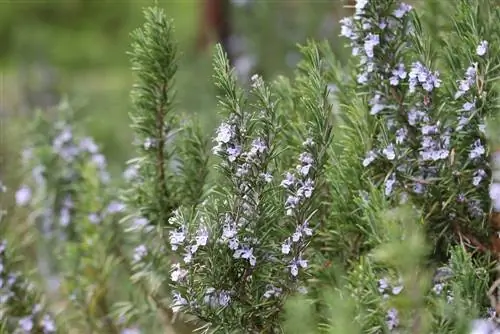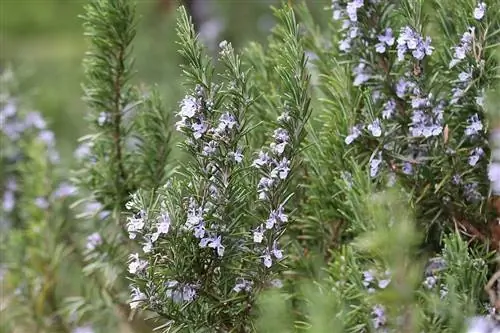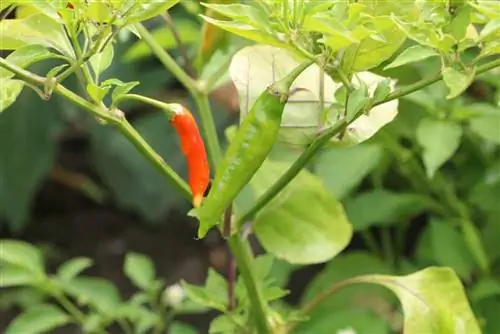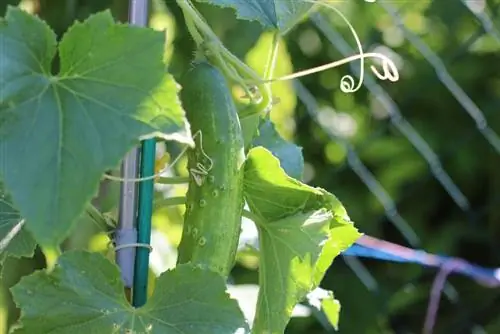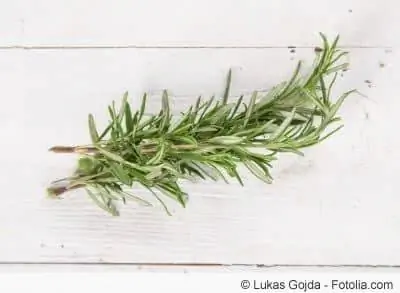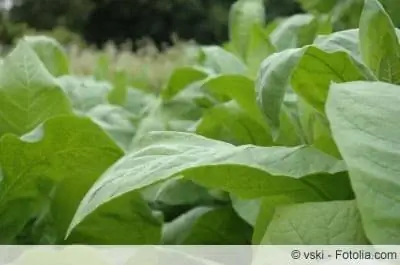- Author admin [email protected].
- Public 2023-12-17 03:39.
- Last modified 2025-01-24 12:45.
Rosemary is a Mediterranean plant that enriches your own herb garden with an aromatic plant. It can be used in the kitchen, consumed fresh or dried and, as a tea, even helps against headaches. It is also easy to care for.
Many good reasons for growing rosemary on the balcony or in the bed. However, if this is to be successful, hobby gardeners must consider a few important points. Because this grateful plant also has demands.
Location
Rosemary comes from the regions around the Mediterranean and therefore requires a lot of warmth and sun. A very sunny and somewhat sheltered location where the heat can accumulate is ideal. House walls and balconies facing south offer the right location. Only in spring should you make sure that the Rosmarinus officinalis does not have to endure too much morning sun. This could damage the still sensitive leaves. Gradual habituation is recommended.
Substrate
Growing rosemary requires a loose substrate that is dry and rich in nutrients. The soil may be calcareous, but not prone to compaction or waterlogging. Commercially available potting soil containing coconut fiber, sand, gravel or expanded clay is ideal. A small addition of compost is also good for rosemary.
Tip:
Because rosemary likes to be kept warm, a layer of gravel or small stones should be placed on the ground. These store the heat of the day well into the night and reduce evaporation.
Pouring
Once you have found the right location and mixed the right substrate, growing rosemary is surprisingly easy. This is already noticeable when watering. Rosmarinus officinalis neither needs collected rainwater nor does it require constant use of the pot. Fresh tap water is completely sufficient because the plant tolerates limescale well. For small pots, submersion makes sense. The planter is placed in a bucket of water until no more air bubbles emerge from the soil. Before putting the rosemary back into the planter, it should be allowed to drain for a few minutes. Otherwise, dangerous waterlogging could occur. When growing in beds, flushing watering in conjunction with a drainage layer is the best choice. The substrate should be able to dry well between each watering. At the latest when the shoot tips hang down slightly, it's time to water again.
Fertilize
Fertilizing rosemary is basically not necessary. Within the first year after repotting or changing the substrate, additional nutrients could even lead to the death of the plant, because rosemary has a very low requirement. If rosemary has been grown in the same soil for a long time, the plants can be supplied very sparingly with commercially available organic liquid fertilizer. Alternatively, use mature compost.
Repotting and moving
In the right location, rosemary grows quite quickly. If it is cultivated in a pot or bucket, sooner or later the container will have to be changed. This should be done in spring when the plants are taken outside again after hibernation. It is advisable to remove the substrate carefully and as completely as possible from the roots and replace it completely. The new planter simply needs to be chosen one size larger.
If you carry out this measure annually, you can completely avoid additional fertilizing. And at the same time prevents infestation by diseases and pests that come from the earth. However, moving it in the bed is not necessary. Unless the location turns out to be unsuitable. Apart from this reason, the rosemary in the garden is better left alone and takes good care of itself.
Culture in pots
Since rosemary comes from warm climates, most varieties are not hardy. Culture in pots or buckets is therefore recommended. The more substrate the plants have available here, the less care they need. Tip: Rosemary goes well with other Mediterranean herbs, such as lavender or sage. Planted together in a pot, the combination offers something for the eyes and the nose - and at the same time keeps some pests and pests away.
Culture in the bed
If you want to grow rosemary on a large scale, you can't avoid planting it in a bed or raised bed. So that the plants don't have to be dug up again every autumn, you should use the newer cultivars. Suitable varieties include Hill Hardy and Arp.
Care in the bed is less time-consuming throughout the year, as the plants largely take care of themselves and only need to be watered when necessary. However, overwintering is a bit difficult even for the varieties mentioned.
Wintering
If the rosemary is in a pot, overwintering is quite easy. The planters are simply brought indoors. The winter quarters should have temperatures of 5°C to 10°C and be very bright. If necessary, the plants are watered sparingly and fertilizing is stopped. If the chosen room is very dry, the plants should be sprayed with water every now and then.
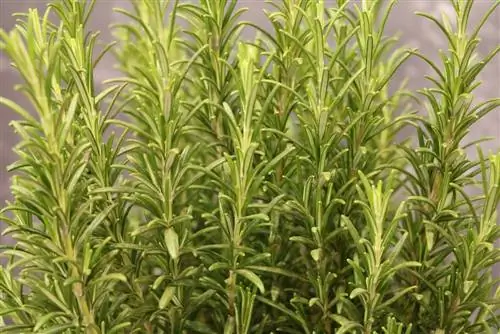
In the bed, however, it's a matter of covering as much as you can. A thick protective layer of straw, leaves and brushwood should be placed on the ground. In windy places, baskets filled with leaves should also be placed over the plants.
Blend
Rosemary is evergreen, but can have dried out branches after winter or during prolonged drought. These should be removed as soon as possible and can still be used as a spice. Individual branches can also be harvested from spring to autumn. However, a basic waste is neither necessary nor recommended.
Typical pests and diseases
Rosemary cultivation can actually only be endangered by pests if it is too dry in winter. This weakens the plants and makes them vulnerable. Various species of lice, mites and flies, which make themselves known through webs, deposits and feeding marks, represent the main dangers. However, they can be easily combated. To do this, the plants are showered and, while still damp, covered with foil for one to three days. The high humidity is bad for the pests and they die. Affected areas must be removed.
Frequently asked questions
Is rosemary poisonous to animals?
No, although animals and people can develop intolerance to it. These usually manifest themselves as nausea, vomiting, diarrhea and rashes.
Why does rosemary lose its needles?
If rosemary's needle-shaped leaves turn brown and then fall off in large quantities, this is usually due to inadequate watering. Although Mediterranean plants tolerate drought, daily watering may be necessary if temperatures continue to be high.
What you should know about rosemary in brief
Location
- The best place is full sun, sheltered, warm, if possible in front of a south wall.
- In spring, rosemary must be protected from too much morning sun.
- The ideal soil is loose, rich in humus, dry, slightly sandy and calcareous, with a drainage layer.
- A layer of gravel around the plant serves as heat storage.
- When planting, always plant the rosemary slightly higher to avoid the risk of waterlogging and soil fungi.
Care and fertilization
- The plant is always watered sparingly. It doesn't need much water.
- Only add a little more water in summer.
- If you water too little, the needles will fall off. Then add a little more water.
- In any case, too much water is worse than too little.
Basic fertilization should be carried out in spring with mature compost or horn shavings. After that, it is recommended to fertilize about twice a month. This phase lasts until mid-August. Then the fertilizer doses are stopped.
Cutting and overwintering
Rosemary can be pruned. You should always take natural growth into account. The crown is cut round or oval. You have to be careful not to cut into old wood.
- Rosemary is not completely hardy. It usually cannot survive severe, long-lasting frost.
- A sheltered spot in the garden can help. The same applies if you cover the plant a little.
If you want to be on the safe side, plant it in a pot and overwinter it indoors:
- Temperatures between 0 and 10 ºC are ideal.
- The air should be moist (humidity at least 60 percent), otherwise there is a risk that pests will settle and undesirable winter growth will begin.
- Wate only sparingly, but the bale must not dry out.
Wintering in a cold house is ideal. There are now also special winter-hardy varieties on the market. You should ask about these when purchasing.
Propagate rosemary
Rosemary is propagated in summer by side shoots that are approximately 10 cm long. They are separated from the trunk with some old wood. You plant them, spray them with water and put a plastic bag over the pot. It can take months for the shoots to grow.
Rosemary can also be propagated by seeds. Sowing takes place between March and April. It can be planted out just one month later. The easiest way is to purchase a plant commercially.

